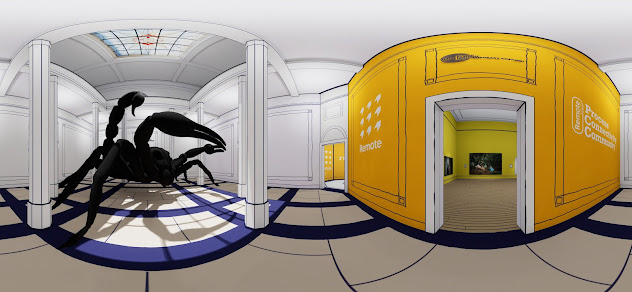I recently installed an exhibition, 'Is Anybody Listening' by Photographer Craig Easton (not in VR this time, but still relevant) at Blackpool School of Arts Gallery. The exhibition came predesigned and packaged and all I had to do was install it. I measured the exhibition and chose the spacing, which is quite important as it's not just about technical uniformity, it can also subtly influence the rhythm and pace of the show etc.
The main point I want to make is how much one learns, as a curator, about the artworks when one is setting out and installing them. However, in this instance, it was already decided for me. So I now don't feel like I 'know' the artworks (photographs in this case) as much as I normally would.
Through the act of selecting and setting out a body of work for exhibition, I become aware of things that one would not notice unless you were fully immersed in the project. For me, it is very important, because I'm also putting myself into the shoes of the eventual viewer and I want to feel or sense what they are likely to do, or where they are likely to go when they enter the gallery.
My job is to help them make sense of what they see before them. I can design a layout so that most people go to a specific piece first, then another, then another etc., and with that, one lays a path of learning and understanding, that (hopefully) introduces them to more detail and nuance over the course of their visit, than they would if they were confronted with all the artworks at once. Of course, all visits are also helped by gallery info panels and labels, but not everyone reads them (or wants to read them) in the same way.
It is through the process of designing a layout, moving artwork around, trying one picture next to another and so on, that one starts to get a really good sense and understanding of the artist and their work. And this knowledge can prove invaluable and allows me to talk with confidence to people (very often my students) about the work on display.
So each time I go through the gallery, I have to make myself pause and try and learn something new about this exhibition and it is proving difficult. If I had at least been able to adjust or edit the order of the works, then I feel I would be in a much better place. This brings me to my final point and one that I have recently been thinking and writing about, and that is the traditionally fractious relationship between the artist and curator and the notion of the artist as a curator.
Now, before I go on, I would like to say that Craig Easton has designed this exhibition very well, especially so, since he does not know the space very well. But, in doing so he has removed one of the great joys of my job and with it, of course, is my greater understanding of his work.
Other curators have not been so kind and openly speak about asking an overenthusiastic artist/want-to-be-curator to get lost. Indeed critic Jeffrey Kipnis warns against including artists in the active process of curation and design of their exhibitions - ‘a show… I understood to be selected and installed by the artist - a risky adventure, in my opinion, as the lawyer who represents himself has a fool for a client’. Curator, Robert Storr gives us a possible reason for this - ‘that some artists are very good, flexible, and creative… Quite a few are not, but only some of them are aware of it. I will be writing more on this subject in the coming months and it's not all bad.
I suppose the purpose of this post, is to highlight elements of a curator's role that are not always obvious and that removing responsibility for something from them does not necessarily help them do their job.
If you are reading this blog and feel you can add something to my research then please comment… even if you are correcting me or don’t agree with something that I say.





























